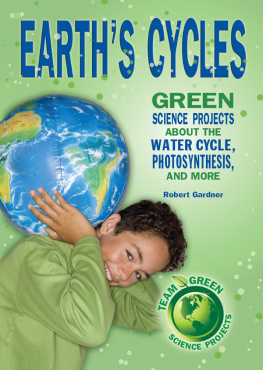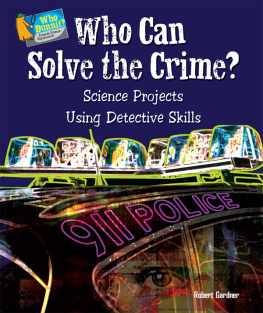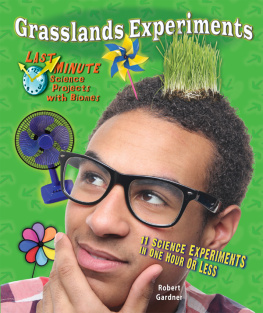Published in 2018 by Enslow Publishing, LLC.
101 W. 23rd Street, Suite 240, New York, NY 10011
Copyright 2018 by Robert Gardner
All rights reserved.
No part of this book may be reproduced by any means without the written permission of the publisher.
Library of Congress Cataloging-in-Publication Data
Names: Gardner, Robert, 1929- author.
Title: Experiments with light / Robert Gardner.
Description: New York, NY : Enslow Publishing, [2018] | Series: Science whiz experiments | Audience: 5-8.
Identifiers: LCCN 2016057788 | ISBN 9780766086807 (library bound ; alk. paper)
Subjects: LCSH: LightExperimentsJuvenile literature.
Classification: LCC QC360 .G3675 2018 | DDC 535.078dc23
LC record available at https://lccn.loc.gov/2016057788
Printed in the United States of America
To Our Readers: We have done our best to make sure all website addresses in this book were active and appropriate when we went to press. However, the author and the publisher have no control over and assume no liability for the material available on those websites or on any websites they may link to. Any comments or suggestions can be sent by e-mail to .
Illustrations by Joseph Hill
Photo Credits: Cover, p..
 Contents
Contents
Introduction
Chapter 1
Sources and Paths of Light
1.1 What Is Lights Normal Path?
1.2 Light in Straight Paths
1.3 The Law of Reflection
1.4 A Mirror Image
1.5 More Mirror Images
1.6 Reflected Light Through Water
1.7 A Look at Refraction
1.8 A Disappearing Glass
1.9 White Light and Colored Light
Chapter 2
A Look at Light and Lenses
2.1 Light Rays from Far Away
2.2 The Science of a Convex Lens
2.3 Distance and Convex Lens Images
2.4 The Science of a Concave Mirror
2.5 Distance and Concave Mirror Images
Chapter 3
The Colors in White Light
3.1 Primary Colors of Light
3.2 Giving Shadows Color
3.3 Reflected Light of Colored Objects
3.4 White Light and Complementary Colors
3.5 Colors in Combination
3.6 Light Through Colored Filters
Chapter 4
The Properties of Light
4.1 Particles and Light
4.2 Waves and Light
4.3 What Is Diffraction?
4.4 Polarized Light
4.5 Polarized Light and Reflection
4.6 Light from the Sky
4.7 Scattering Sunlight
4.8 Polarized Sunglasses
4.9 A Spin on Polarized Light
4.10 Bubbles and Bands of Color
Chapter 5
Its Just an Illusion
5.1 Heat and Mirages
5.2 A Black and White Illusion
5.3 The Size of the Rising Moon
5.4 What Is an Afterimage?
5.5 More Illusions
Appendix: Science Supply Companies
Sources of Light Filters
Glossary
Further Reading
Index
About the Author
Introduction
Life on planet Earth would not be possible without light. Sunlight heats our world and provides the energy plants need to make food. But what exactly is light? The behavior and properties of light are a fascinating branch of science called optics. Scientists who study light are physicists.
In this book, you will learn about light by doing experiments. Experimenting provides an understanding you cannot gain simply by reading. You will see that ordinary white light can be broken up into colors. You will find ways to mix (combine) those colored lights to form colors that will surprise you. You will learn how light can sometimes fool you. Things you think you see are not really there; they are mirages or illusions. You will discover how mirrors, lenses, and even pinholes form images, how light can be bent, reflected, polarized, absorbed, and much more. The beauty of experimenting with light is that you can literally see the results.
If you enjoy experimenting with light, you may want to continue learning about light by studying physics in high school and college. It could even become part of your lifes work if you become a physicist, optician, optometrist, ophthalmologist, optical technician, or another occupation based on light.
At times, as you carry out the activities in this book, you may need a partner to help you. Try to work with someone who enjoys experimenting with light as much as you do. That way, you will both enjoy what you are doing. If any danger is involved in doing an experiment, it will be announced to you. In some cases, to avoid danger, you will be asked to work with an adult. Please do so. Dont take any chances that could lead to an injury.
Like any good scientist, you will find it useful to record ideas, notes, data, and anything you can conclude from your investigations in a notebook. This way you can keep track of the information you gather and the conclusions you reach. It will allow you to refer back to things you have done and help you in doing other projects in the future.
Entering a Science Fair
Some of the investigations in this book contain ideas you might use at a science fair. However, judges at science fairs do not reward projects or experiments that are simply copied from a book. For example, a diagram of the electromagnetic spectrum would not impress most judges; however, finding unique ways to measure the wavelength of light or the energy of different wavelengths would certainly attract their attention.
Science fair judges tend to reward creative thought and imagination. It is difficult to be creative or imaginative unless you are really interested in your project, so try to choose an investigation that appeals to you. Before you jump into a project, consider, too, your own talents and the cost of the materials you will need.
If you decide to use an experiment or idea found in this book for a science fair, you should modify or extend it. This should not be difficult because you will discover as you carry out investigations, new ideas come to mind. Ideas will come to you that could make excellent science fair projects, particularly because the ideas are your own and are interesting to you.
If you decide to enter a science fair and have never done so, you should read some of the books listed in the Further Reading section. These books deal specifically with science fairs and will provide plenty of hints and useful information that will help you to avoid the problems that first-time entrants sometimes experience. Youll learn how to prepare appealing reports that include charts and graphs, how to set up and display your work, how to present your project, and how to relate to judges and visitors.
Be Safe
Most of the projects included in this book are very safe. However, the following safety rules are well worth reading before you start any project.
1.Never look directly at the sun! It can damage your eyes.
2.Do any experiments or projects, whether from this book or of your own design, under the supervision of a science teacher or other knowledgeable adult.
3.Read all instructions carefully before beginning a project. If you have questions, check with your supervisor before going any further.
4.Maintain a serious attitude while conducting experiments. Fooling around can be dangerous to you and to others.
5.Wear approved safety goggles when you are working with a flame or doing anything that might injure your eyes.
6.Have a first aid kit nearby while you are experimenting.






















 Contents
Contents